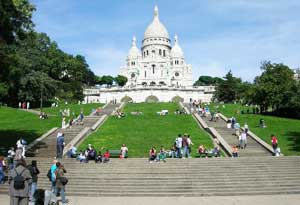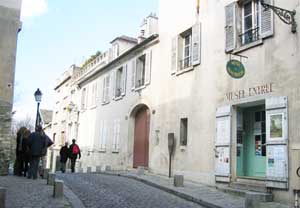Montmartre is one of those rare places in Paris where equal amounts of tourists and locals mix seamlessly.
The Basilique du Sacré-Coeur is the jewel in the crown of this hill-top district, even though the majestic snow-white structure is so at odds with the bohemian village that surrounds it.
And a village it is, well as much as anything in the center of Paris can be a village.
It is named Montmartre as in “Mount of the Martyr” for St. Denis, who was beheaded there by the Romans in AD 260.

Until World War I, Montmartre was center of artistic and intellectual life in Paris. Quite impressively, Montmartre is also the birthplace of the Cubism movement.
The area is popular today with tourists looking for a bit of the old bohemian spirit but also with locals who are still taken in by the village atmosphere. The Place du Tertre is still a meeting place for artists and it’s a great place to look for budget accommodation or restaurants.
If you venture off the beaten track you’ll be rewarded with little-known museums, quaint churches and acclaimed theatres.
Pigalle is the area around Place Pigalle in Montmartre, notorious for cabaret shows and prostitution. The Allied soldiers nicknamed the neighborhood "Pig Alley"in World War II due to it's salubrious reputation.
Famous cabarets like Moulin Rouge and the Divan du Monde are located in Pigalle. Popular with tourists due to its immortalization by Hollywood as well as by many artists, the area isn't very safe at night. Although it is heavily policed, we suggest to avoid this neighborhood after dark.
Montmartre has always been a part of Paris quite unlike the rest. At the end of the 19th century it was drawing artists and writers to its cobbled streets in droves and now the crowds still come, only the artists have been replaced by tourists in search of a souvenir gift and a good view.
The Sacré-Coeur and the Moulin Rouge are by far the most famous of Montmartre's sights, but there by no means the only things worth seeing in this part of the city.
If you take the time to wander, and you should, you will discover so much more.
Place du Tertre
Montmartre still attracts artists and this square is where you will find them. Sadly the likes of Van Gogh and Picasso are long gone, replaced instead by artists selling their sketches of Paris to tourists. The square is pretty, though often crowded, and if you are souvenir hunting, look no further.

Musée de Montmartre
It is not hard to envision this mansion, in the early 1900s, as a studio in which artists would carry out their work. Obviously, it now houses the museum devoted to the history of Montmartre. The highlights are the posters by Toulouse-Lautrec and the 2nd floor view of the Paris' only vineyard.
Studio 28
This is a little movie house with a big reputation. Since it opened in 1928, writers and artists have flocked here to see the creations of up and coming directors like Truffaut or Orson Welles. This celebrated cinema also features in Amélie. Today it shows first-runs, just-runs and previews and there is a charming little bar.
Musée de l'Érotisme
Surprise, surprise, the city's red light district also houses its Erotic museum. Given the limited subject matter, the owners have done well to fill the seven floors of this building with erotic art and artifacts from all over the world. The fourth floor is a history of Paris brothels and the top floors are temporary exhibitions by contemporary artists, obviously related to the museum's theme.